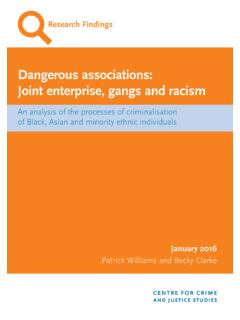Transcription of Knife crime: A problem solving guide
1 Knife crimeA problem solving guideKnife crime: A problem solving College of policing Limited (2021)This publication is licensed under the terms of the Non-Commercial College Licence except where otherwise stated. To view this licence, visit we have identified any third-party copyright information, you will need to obtain permission from the copyright holders concerned. This publication may contain public sector information licensed under the Open Government Licence at version/3 This publication is available for download at you have any enquiries regarding this publication, please contact us at document has been created with the intention of making the content accessible to the widest range of people, regardless of disability or impairment.
2 To enquire about having this document provided in an alternative format, please contact us at guide has been produced in sections to enable quick access to information. this means depending what stage you are at in solving your Knife crime problem , you can move between Scanning, Analysis, Response and crime: A problem solving 3 Foreword by Andy Marsh, Chief Executive 4 Foreword by DAC Graham McNulty, NPCC Knife crime lead 5 About this guide 6 Defining Knife crime 8 The scope of this guide 9 Defining police problem solving 10 What is problem solving ? 10 What does problem solving involve?
3 11 Does problem solving work? 11 Will problem solving work for me? 11 Scanning 12 Selecting a suitable Knife crime problem 12 Selecting a specific Knife crime problem 14 Describing how your local Knife crime problem is patterned 15 Data and intelligence sources for Knife crime problem solving 17 Scanning checklist 25 Analysis 26 The problem analysis triangle 29 Crime scripts 32 Asking the right questions about your local Knife crime problem 34 Analysis checklist 44 Response
4 45 What has worked previously to reduce Knife crime? 46 Will a response work for me in addressing my local Knife crime problem ? 46 Knife crime: A problem solving responses to Knife crime 47 School-based interventions 53 Stop and search 57 Focused deterrence 61 Import enforcement 65 Knife sweeps 72 Knife bins 76 Knife arches 80 Teachable moments in victim interventions 84 Response checklist 89 Assessment 90 Why assess when problem solving ? 90 Purpose of assessment one: To decide if continued problem - solving efforts are needed 91 Purpose of assessment two: For lessons for future problem solving 94 Measuring effects in Knife crime projects 95 The practice of assessment.
5 SARA meets EMMIE 102 Assessment checklist 110 Recommended readings and resources 122 Knife crime 122 problem solving 122 Web resources 123 References 124 Authors 132 How this guide was produced 132 How to cite this guide 133 Acknowledgements 133 Knife crime: A problem solving 1: Knife crime patternsBox 2: Overview of data relevant to problem solving Knife crimeBox 3: How and why are weapons used?Box 4: Analysing Knife crime offenders: a case studyBox 5: Examining the links between Knife crime victims and offendersBox 6: Analysing Knife crime places and timesBox 7: Analysing knives: the four A s of Knife selectionBox 8: What is EMMIE?
6 Box 9: What is a logic model and how do I use one?Box 10: Distinguishing outputs from outcomes, and why it mattersBox 11: Communications and publicity for Knife crime preventionBox 12: Partners in Knife crime prevention, and how to mobilise themBox 13: Methods for measuring the effects of an interventionBox 14: Before-and-after study evaluation of Knife crime prevention initiativeBox 15: Assessment plan for hypothetical Knife arch operationBox 16: Assessment plan for hypothetical Knife sweep operationKnife crime: A problem solving by Andy Marsh, Chief ExecutiveKnife crime can destroy lives and fracture communities. It disproportionately blights the lives of the young and disadvantaged.
7 After decreasing in the early 2010s, it has risen in recent years. Tackling it must be one of policing s top College has produced this guide to support forces in tackling this complex type of crime, equipping officers in all forces with good practice from across the UK and beyond. While there are no simple answers, we have provided a practical toolkit of tactics forces can use, depending on what the data shows in their area, such as interventions in schools, weapon sweeps and focused setting out the strengths and limitations of each type of action, how they work and where they work best, the guide provides what is needed to help tailor a response to local problems. It builds on our Knife crime evidence briefing, published in April 2019, which set out in more general terms the broad approaches that are effective in tackling Knife our expertise as the What Works Centre for Crime Reduction, the content in this guide is grounded in the best available evidence of what is effective in fighting crime.
8 The guide has a strong focus on using data to understand problems, design responses, measure effectiveness and drive approaches will work in different places. By using data effectively, we can truly understand all the dimensions of the local problem and deliver a response that saves lives, protects communities and builds public using this toolkit, officers responding to Knife crime, as well as supervisors and senior leaders, should be confident to tackle the problems in their community, knowing that they are using interventions that work. 1 Knife crime statistics House of Commons Library ( ) Knife crime: A problem solving by DAC Graham McNulty, NPCC Knife crime leadEvery police service in the UK has its own approach to tackling Knife crime and to supporting and protecting their diverse communities.
9 As the National Police Chiefs Council (NPCC) lead for Knife crime, I understand this. I also know the reasons people turn to crime may be complex and based on a large number of personal experiences or environmental Knife crime is a key element in tackling violence. Officers across the country work day and night to protect the communities exposed to this abhorrent crime. Reducing Knife crime requires a response from everyone in society. The public, private and third sectors must work together to deliver a lasting change. People are at the heart of policing and we all have a part to do our best in policing to predict where and when Knife crime may occur and use the current tactics available to us to deploy our resources effectively.
10 We use a range of enforcement, prevention and engagement tactics to take knives off the streets. But with the right information we can make smarter, more informed this work, we hope to do exactly that, using the right tactics to suit our communities, ultimately deterring people from carrying knives and reducing violence on our streets. This guide provides an excellent resource for police forces across the country to get the best from their officers and staff, deploy them effectively and work with partner agencies more research informs us on how we can use a scientific, evidence-based approach to reduce crime. It gives us some of the tactics available to tackle Knife crime and assesses their viability, weighing up both positive and negative aspects of their use.











